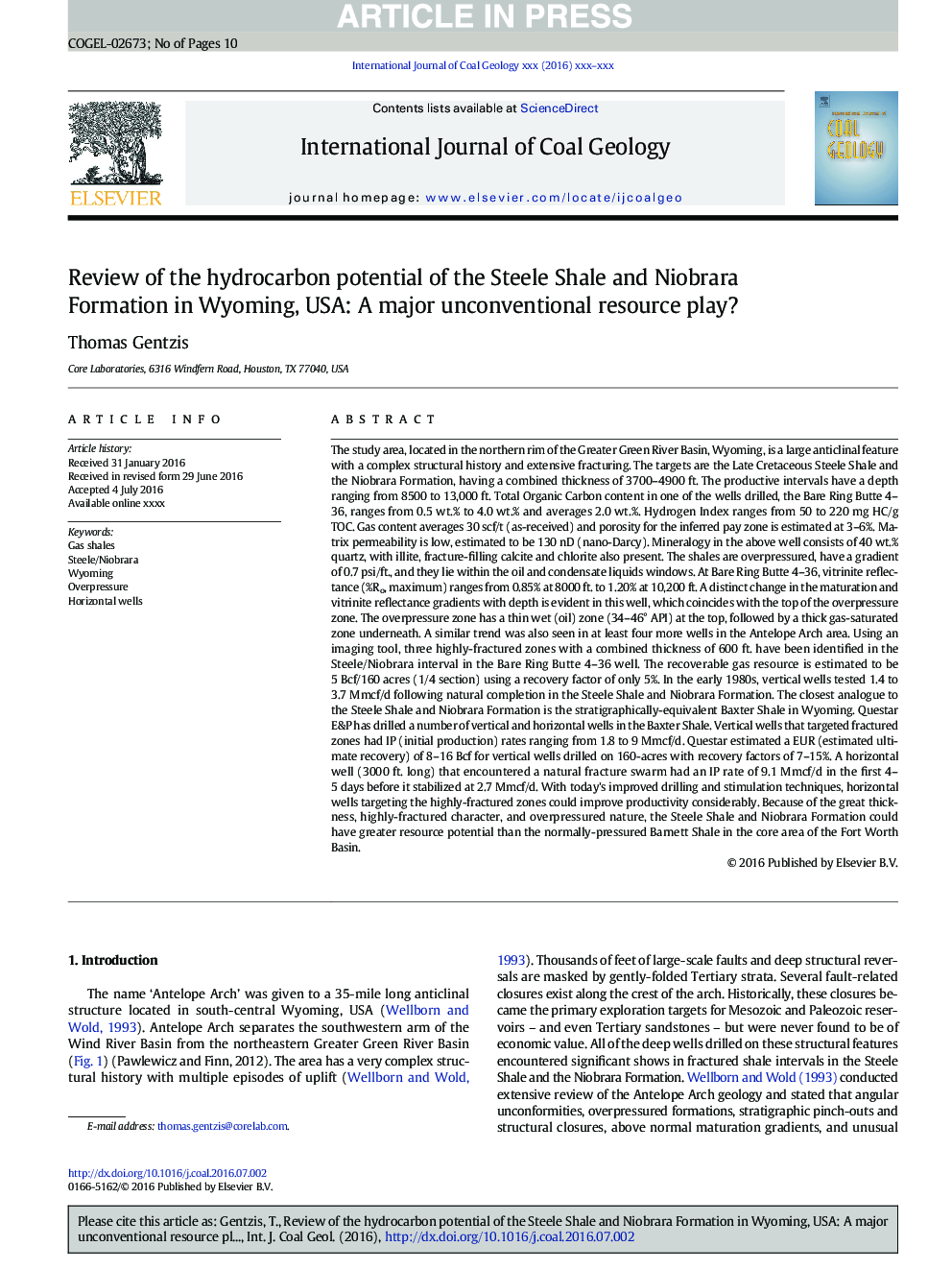| کد مقاله | کد نشریه | سال انتشار | مقاله انگلیسی | نسخه تمام متن |
|---|---|---|---|---|
| 5483697 | 1522537 | 2016 | 10 صفحه PDF | دانلود رایگان |
عنوان انگلیسی مقاله ISI
Review of the hydrocarbon potential of the Steele Shale and Niobrara Formation in Wyoming, USA: A major unconventional resource play?
ترجمه فارسی عنوان
بررسی پتانسیل هیدروکربن سازند ستیل شیل و سازند نیوبارا در وایومینگ، ایالات متحده آمریکا: یک بازی مهم غیر متعارف؟
دانلود مقاله + سفارش ترجمه
دانلود مقاله ISI انگلیسی
رایگان برای ایرانیان
کلمات کلیدی
شیلات گاز، استیل / نویبارا، وایومینگ، بیش از حد، چاه های افقی
موضوعات مرتبط
مهندسی و علوم پایه
علوم زمین و سیارات
زمین شناسی اقتصادی
چکیده انگلیسی
The study area, located in the northern rim of the Greater Green River Basin, Wyoming, is a large anticlinal feature with a complex structural history and extensive fracturing. The targets are the Late Cretaceous Steele Shale and the Niobrara Formation, having a combined thickness of 3700-4900 ft. The productive intervals have a depth ranging from 8500 to 13,000 ft. Total Organic Carbon content in one of the wells drilled, the Bare Ring Butte 4-36, ranges from 0.5 wt.% to 4.0 wt.% and averages 2.0 wt.%. Hydrogen Index ranges from 50 to 220 mg HC/g TOC. Gas content averages 30 scf/t (as-received) and porosity for the inferred pay zone is estimated at 3-6%. Matrix permeability is low, estimated to be 130 nD (nano-Darcy). Mineralogy in the above well consists of 40 wt.% quartz, with illite, fracture-filling calcite and chlorite also present. The shales are overpressured, have a gradient of 0.7 psi/ft., and they lie within the oil and condensate liquids windows. At Bare Ring Butte 4-36, vitrinite reflectance (%Ro, maximum) ranges from 0.85% at 8000 ft. to 1.20% at 10,200 ft. A distinct change in the maturation and vitrinite reflectance gradients with depth is evident in this well, which coincides with the top of the overpressure zone. The overpressure zone has a thin wet (oil) zone (34-46° API) at the top, followed by a thick gas-saturated zone underneath. A similar trend was also seen in at least four more wells in the Antelope Arch area. Using an imaging tool, three highly-fractured zones with a combined thickness of 600 ft. have been identified in the Steele/Niobrara interval in the Bare Ring Butte 4-36 well. The recoverable gas resource is estimated to be 5 Bcf/160 acres (1/4 section) using a recovery factor of only 5%. In the early 1980s, vertical wells tested 1.4 to 3.7 Mmcf/d following natural completion in the Steele Shale and Niobrara Formation. The closest analogue to the Steele Shale and Niobrara Formation is the stratigraphically-equivalent Baxter Shale in Wyoming. Questar E&P has drilled a number of vertical and horizontal wells in the Baxter Shale. Vertical wells that targeted fractured zones had IP (initial production) rates ranging from 1.8 to 9 Mmcf/d. Questar estimated a EUR (estimated ultimate recovery) of 8-16 Bcf for vertical wells drilled on 160-acres with recovery factors of 7-15%. A horizontal well (3000 ft. long) that encountered a natural fracture swarm had an IP rate of 9.1 Mmcf/d in the first 4-5 days before it stabilized at 2.7 Mmcf/d. With today's improved drilling and stimulation techniques, horizontal wells targeting the highly-fractured zones could improve productivity considerably. Because of the great thickness, highly-fractured character, and overpressured nature, the Steele Shale and Niobrara Formation could have greater resource potential than the normally-pressured Barnett Shale in the core area of the Fort Worth Basin.
ناشر
Database: Elsevier - ScienceDirect (ساینس دایرکت)
Journal: International Journal of Coal Geology - Volume 166, 1 September 2016, Pages 118-127
Journal: International Journal of Coal Geology - Volume 166, 1 September 2016, Pages 118-127
نویسندگان
Thomas Gentzis,
